
Oolong is a traditional semi-oxidized Chinese tea produced through a process including withering the plant under strong sun and oxidation before curling and twisting. Most oolong teas, especially those of fine quality, involve unique tea plant cultivars that are exclusively used for particular varieties. The degree of oxidation, which varies according to the chosen duration of time before firing, can range from 8 to 85%, depending on the variety and production style. Oolong is especially popular in south China and among ethnic Chinese in Southeast Asia as is the Fujian preparation process known as the Gongfu tea ceremony.

A teapot is a vessel used for steeping tea leaves or a herbal mix in boiling or near-boiling water, and for serving the resulting infusion which is called tea. It is one of the core components of teaware. Dry tea is available either in tea bags or as loose tea, in which case a tea infuser or tea strainer may be of some assistance, either to hold the leaves as they steep or to catch the leaves inside the teapot when the tea is poured. Teapots usually have an opening with a lid at their top, where the dry tea and hot water are added, a handle for holding by hand and a spout through which the tea is served. Some teapots have a strainer built-in on the inner edge of the spout. A small air hole in the lid is often created to stop the spout from dripping and splashing when tea is poured. In modern times, a thermally insulating cover called a tea cosy may be used to enhance the steeping process or to prevent the contents of the teapot from cooling too rapidly.

Chinese tea culture includes all facets of tea, both physical and spiritual, that significantly influenced Chinese culture throughout history. Physically, it consists of the history of tea cultivation, brewing, serving techniques, methods of consumption, arts, and the tea ceremony. Tea culture is to take tea as a carrier, and through this carrier to spread various arts. Tea culture is an integral part of the excellent traditional Chinese culture, and its content is very rich. Tea culture is the organic fusion of tea and culture, which contains and embodies the manifestation of a certain period of material and spiritual civilization. Tea culture is the combination of tea art and spirit, and the expression of tea art through Spirituality. It emerged in China in the Tang Dynasty, flourished in the Song and Ming Dynasties, and declined in the Qing Dynasty.

A French press, also known as a cafetière, cafetière à piston, caffettiera a stantuffo, press pot, coffee press, or coffee plunger, is a coffee brewing device, although it can also be used for other tasks. In 1923 Ugo Paolini, an Italian, filed patent documents relating to a tomato juice separator and he developed the idea of making a coffee pot with a press action and a filter. He assigned his 1928 patent to Italian designer Attilio Calimani and Giulio Moneta who filed it in 1929.

Sprouting is the natural process by which seeds or spores germinate and put out shoots, and already established plants produce new leaves or buds, or other structures experience further growth.

Pu'er or pu-erh is a variety of fermented tea traditionally produced in Yunnan Province, China. In the context of traditional Chinese tea production terminology, fermentation refers to microbial fermentation, and is typically applied after the tea leaves have been sufficiently dried and rolled. As the tea undergoes controlled microbial fermentation, it also continues to oxidize, which is also controlled, until the desired flavors are reached. This process produces tea known as 黑茶 hēichá. Pu'er falls under a larger category of fermented teas commonly translated as dark teas.
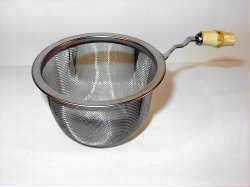
A tea strainer is a type of strainer that is placed over or in a teacup to catch loose tea leaves.

Steeping is the soaking of an organic solid, such as leaves, in a liquid to extract flavours or to soften it. The specific process of teas being prepared for drinking by leaving the leaves in heated water to release the flavour and nutrients is known as steeping. Herbal teas may be prepared by decoction, infusion, or maceration. Some solids are soaked to remove an ingredient, such as salt, where the solute is not the desired product.

Tetsubin (鉄瓶) are Japanese cast-iron kettles with a pouring spout, a lid, and a handle crossing over the top, used for boiling and pouring hot water for drinking purposes, such as for making tea.

Longjing tea, sometimes called by its literal translated name Dragon Well tea, is a variety of pan-roasted green tea from the area of Longjing Village in Hangzhou, Zhejiang Province, China. It is produced mostly by hand and renowned for its high quality, earning it the China Famous Tea title.
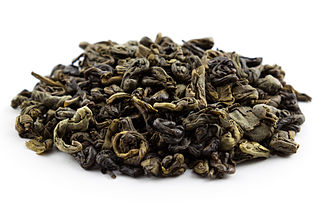
Gunpowder tea is a form of tea in which each leaf has been rolled into a small round pellet. Its English name comes from its resemblance to grains of gunpowder. This rolling method of shaping tea is most often applied either to dried green tea or oolong tea.
ISO 3103 is a standard published by the International Organization for Standardization, specifying a standardized method for brewing tea, possibly sampled by the standardized methods described in ISO 1839. It was originally laid down in 1980 as BS 6008:1980 by the British Standards Institution, and a revision was published in December, 2019 as ISO/NP 3103. It was produced by ISO Technical Committee 34, Sub-Committee 8 (Tea).
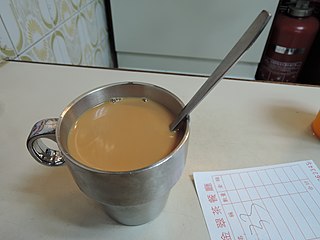
Hong Kong-style milk tea is a tea drink made from Ceylon tea, black tea and milk. It is usually part of lunch in Hong Kong tea culture. Hongkongers consume approximately a total of 900 million glasses/cups per year. Although originating from Hong Kong, it can also be found overseas in restaurants serving Hong Kong cuisine and Hong Kong-style western cuisine. In the show Top Eat 100, which aired on 4 February 2012, Hong Kong-style milk tea was listed as the 4th most popular food/drink in Hong Kong. The unique tea making technique is listed on the representative list of the Intangible Cultural Heritage of Hong Kong.
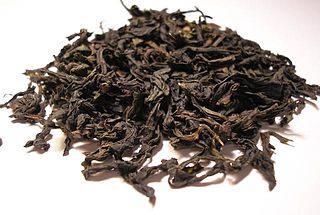
Da Hong Pao is a Wuyi rock tea grown in the Wuyi Mountains of Fujian Province, China. Da Hong Pao has a unique orchid fragrance and a long-lasting sweet aftertaste. Dry Da Hong Pao has a shape like tightly knotted ropes or slightly twisted strips, and is green and brown in color. After brewing, the tea is orange-yellow, bright and clear. Da Hong Pao can retain its flavor for nine steepings. The tea is often known to be extremely expensive.

Infusion is the process of extracting chemical compounds or flavors from plant material in a solvent such as water, oil or alcohol, by allowing the material to remain suspended in the solvent over time. An infusion is also the name for the resultant liquid. The process of infusion is distinct from both decoction—a method of extraction involving boiling the plant material—and percolation, in which water is passed through the material.
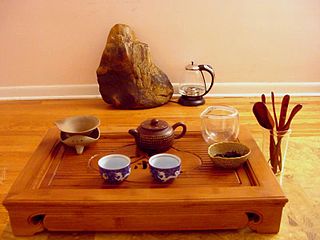
The gongfu tea ceremony or kung fu tea ceremony, is a type of Chinese tea ceremony, involving the ritual preparation and presentation of tea. It is probably based on the tea preparation approaches originated in Fujian and the Chaoshan area of eastern Guangdong. The term literally means "making tea with skill". The approach often involves using smaller brewing vessels and a higher leaf-to-water ratio than in western-style brewing. Today, the approach is used popularly by teashops carrying tea of Chinese origins, and by tea connoisseurs as a way to maximize the taste of a tea selection, especially a finer one.

A gaiwan or zhong (盅) is a Chinese lidded bowl without a handle, used for the infusion of tea leaves and the consumption of tea. It was invented during the Ming dynasty. It consists of a bowl, a lid, and a saucer.

Lotus tea is an infusion made from lotus leaves, flowers, roots, fruit, seeds, or embryos. It is known as liánchá in Chinese and yeoncha in Korean. It is also known as trà sen in Vietnamese.
Scarification in botany involves weakening, opening, or otherwise altering the coat of a seed to encourage germination. Scarification is often done mechanically, thermally, and chemically. The seeds of many plant species are often impervious to water and gases, thus preventing or delaying germination. Any process designed to make the testa more permeable to water and gases is known as scarification.

Doodh pati chai is a tea beverage, originating from the Indian subcontinent, consumed in India, Pakistan, Bangladesh, Afghanistan and Nepal in which milk, together with sugar, is boiled with tea. Doodh pati is different from saada chai, in that it only uses milk and tea. This tea is quite common in South Asia. It is marginally costlier than the regular, water-based saada chai.



















